Thessaloniki: 6 Creative Locals Offer Their Own Tips
Six creative Thessaloniki locals share their...
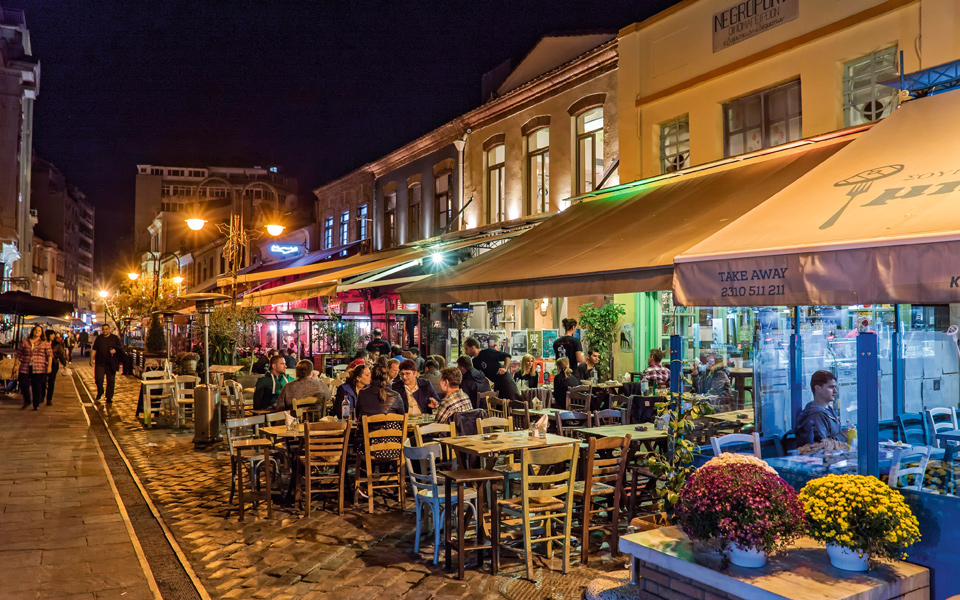
Ladadika neighborhood, the epicenter of the city's nightlife entertainment.
© Perikles Merakos
Old color postcards of Thessaloniki, the kind that French and British soldiers stationed here in WWI used to send to their families, preserve the charm and exoticism of the Ladadika neighborhood. In 1915 the city was used by the Allies as a launching pad for troops assigned to battle in the Balkan mainland. Due to its optimal location close to the port, the Ladadika neighborhood was where all business related to the provisioning of the city was conducted. After all, ever since Ottoman rule, this was where the storehouses for oil, spices and foodstuffs were located. Soon, other types of “trade” appeared: dozens of brothels, musical cafés, pastry shops, dance halls and taverns cropped up to cater to the soldiers’ various needs, turning the area into a multiethnic and multiracial Babel of business and pleasure.
Next to the extant Jewish, Muslim and Greek business owners and residents, and almost in front of the offices of shipping companies and state-owned companies, stood “houses of entertainment” for the thousands of European soldiers and their colonized brethren-in-arms from Africa and the Orient. Music and red lights; hotel ballrooms; spies skulking both undercover and out in the open; soldiers and civilians: all were woven together in the area’s prevailing image as the center of a vibrant nightlife and eroticism that rocked Thessaloniki to its cosmopolican rhythms. Imagine something along the lines of Fellini’s film Nights of Cabiria spliced together with George Wilhem Pabst’s Salonica, a nest of spies (1936). This will give you a sense of the hedonism and heady pulse of life in Ladadika during that period.
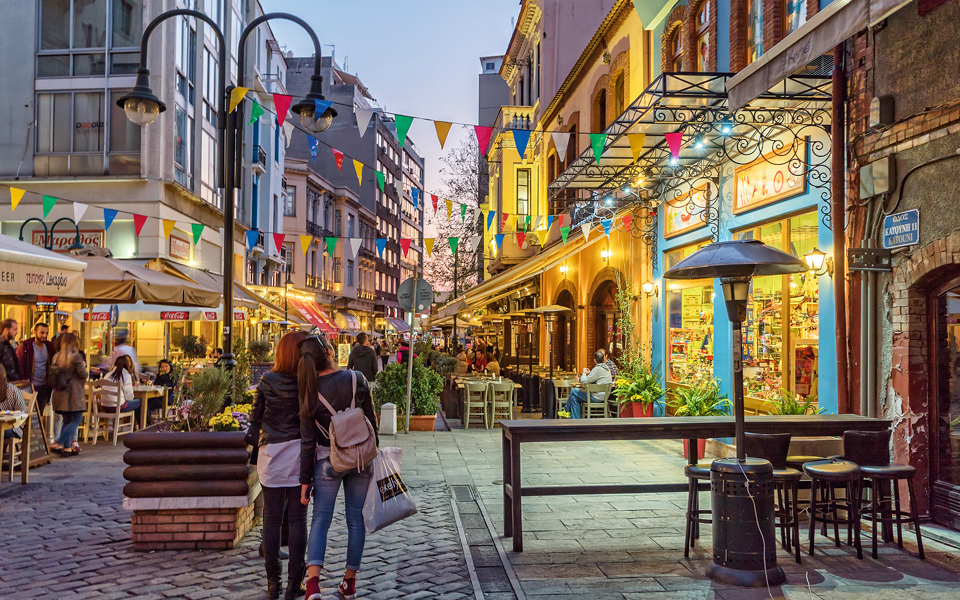
Pedestrianized Katouni Street is the area’s main thoroughfare.
© Perikles Merakos
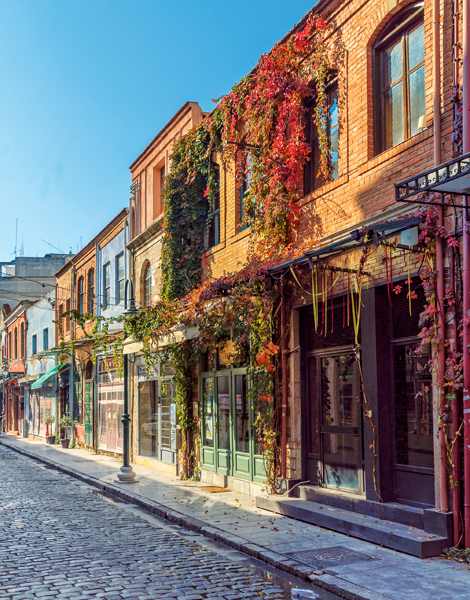
Unchanged by time. The area’s revamp in the early 1990s was designed to take us back to the late 19th century.
© Perikles Merakos
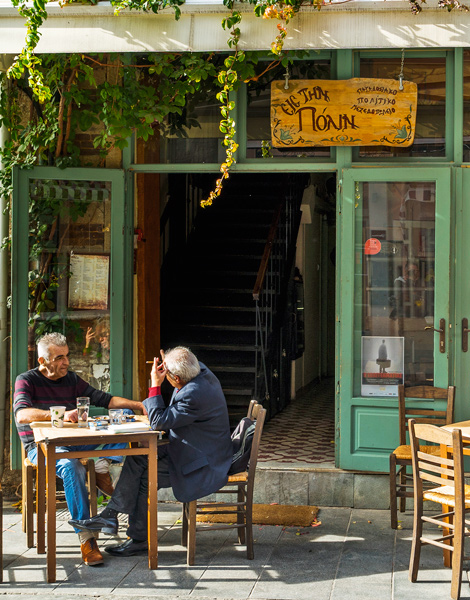
A traditional café, one of many in the area. Try a Greek coffee with a loukoumi (delight).
© Perikles Merakos
“ What is Greek kefi? You will see! Especially in the area that the locals call Valaoritou ”
The neighborhood is an example of the architectural idiosyncracies and urban planning typical of Balkan city business centers at the beginning of the 20th century. Ladadika’s neighborhoods, preserved intact to this day, present us with a medley of tiny spaces, workshops, warehouses, tenements, elaborate brick buildings, stone covered in plaster – austere simplicity cheek by jowl with the most intricate ornamentation. Morihovou Square, known as the area’s hub, is dominated by the eclectic cadences of the Bristol Hotel. Imposing and impeccably restored, it serves as an eloquent reminder of what Ladadika was before its decline, precipitated by radical changes in business practices at the end of WWII.
At that time, Thessaloniki’s business center moved elsewhere and the neighborhood was ghettoized, relegated to the city’s margins. Cheap prostitutes, outcasts, and all manner of illegal activity reinforce the area’s blight. The area became a refuge for rock band studios and moonstruck writers who, inspired by the surrounding rottenness, wrote eulogies to decadence. Until, that is, 1992 – a pivotal date in the story of the neighborhood’s revitalization and reinstatement as central to the life of Thessaloniki.
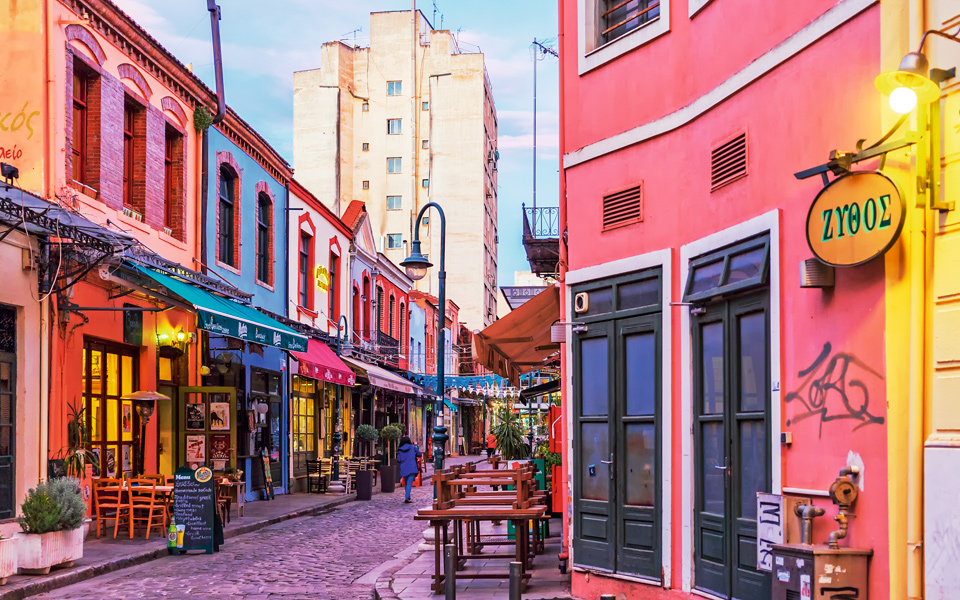
The buildings have been restored with their original colors.
© Perikles Merakos
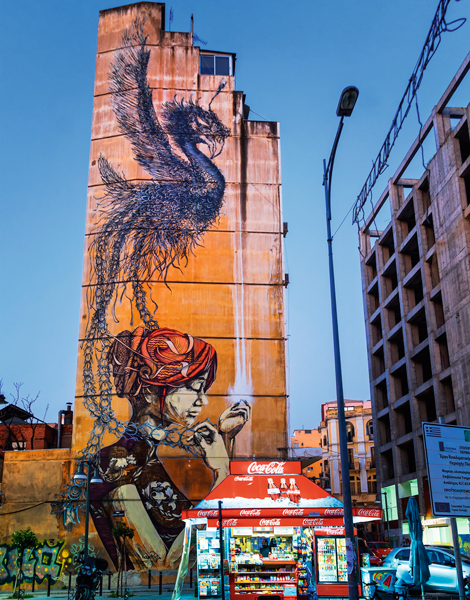
This gigantic mural was created for the Biennale for Young Artists in 2011.
© Perikles Merakos
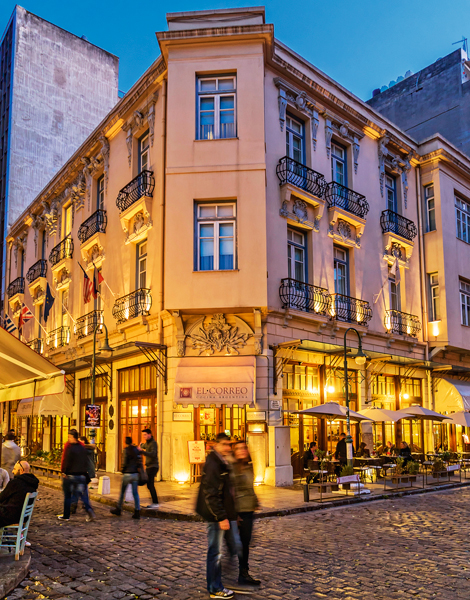
The facade of the historic Bristol Hotel.
© Perikles Merakos
In 1992, the Ladadika neighborhood was included in a new urban planning and improvement project. Hundreds of buildings from the interwar period were restored and declared protected historic landmarks. As if by magic, their rooms once again filled with the frantic, hedonistic pulse of nightlife. Both sides of Tsimiski Street became crowded with restaurants, bars and clubs – an amusement park of sorts specializing in a variety of indulgences and pleasures. To this day, the area is on every local and visitor’s bucket list.
There are dozens of ouzeri, restaurants and specialized eateries focusing not only on Mediterranean and Greek food, but also Italian, Spanish and even Argentinian, Chinese and American. With such an incredible range to choose from, you are guaranteed a fine dining experience. As you wander along Ladadika’s side streets, you will surely happen upon wines and gourmet dishes that will warm your heart.
After your meal, next to the restaurant strip, you will find an equally impressive range of bars and clubs with both Greek and international music. What is Greek kefi? You will see! Especially in the area that the locals call “Valaoritou,” youthful Thessaloniki paints the town red, all night, every night, until dawn. Like London’s Soho, Berlin’s Kreuzberg and Mama Roma’s Trastevere, today’s Ladadika continues to be the epicenter of cosmopolitan entertainment, presenting us with an unadulterated image (despite the economic crisis) of a fun-loving, always vibrant Thessaloniki. Enjoy!
Zithos | A selection of beers from all over the world and the finest specialties of Greek cuisine. Frequented by artists and foodies from all over Greece. Our recommendation: no matter what you order, make sure you include the dill salad – it’s their signature dish. [5 Katouni • Tel. (+30) 2113.115.555]
Bakalarakia Aristo | A glass of retsina accompanied by garlic dip and fish-and-chips served on grease-proof paper. This is a traditional recipe from Thessaloniki’s port, the equivalent of the British classic, and a local lunch favorite. [2 Katouni • Tel. (+30) 2310.548.668]
Negroponte | A trip back to Thessaloniki’s cuisine from the interwar period, with wines and dishes that call for sharing. Our recommendation: make sure you order the fried pork with yogurt. It’s sinfully good. [24 Aigiptou • Tel. (+30) 2310.523.571]
La Doze | A cocktail bar and gallery rolled into one, it is where you will find Thessaloniki’s artists, trendsetters and devotees of the alternative music scene. Cutting edge in every way: space, music, happenings and themed evenings. [1 Villara (Singrou) • Tel. (+30) 2310.922.247]
Urania | Located on the second floor of a restored neoclassical building, the congenial blend of space, music, drinks, and undeniably cheery clientele found here stretch out the night’s pleasures. [4 Paikou & 7 Kapodistriou • Tel. (+30) 2315.527.999]
Six creative Thessaloniki locals share their...
The Thessaloniki-born winemaker welcomes us to...
The West Wall Collective revitalizes Thessaloniki’s...
Where dusk, movement, and memory meet,...